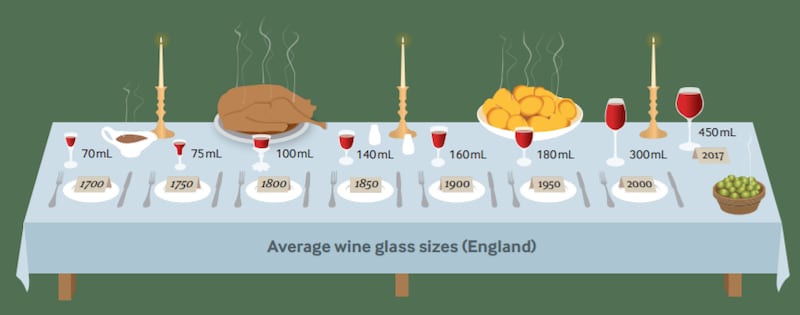Wine glasses have gotten seven times larger over the last 300 years, with the biggest increases occurring over the last two decades, a new study has found.
Glass capacity increased from 66ml in the 1700s to a mean wine glass size of 449ml in 2017, according to the British Medical Journal (BMJ) study.
The researchers said it is hard to say if the increase in glass size is leading or responding to increased thirst for wine among populations.
Does (wine) size matter? A look at how wine glass sizes changed from 1700 to 2017 and whether downsizing could reduce consumption #BMJChristmas https://t.co/SopO3hNfIh pic.twitter.com/TfO3cYQ194
— The BMJ (@bmj_latest) December 14, 2017

The study said the growth in glass size has certainly dovetailed with an increase in consumption of wine, which in Ireland saw a record-equalling 9 million cases sold last year, matching the figure for 2011.
The study is released just in time to save as ammunition for an interesting anecdote for the Christmas day dinner table.
The research may also come in handy the morning after any festive night out, allowing people to place the blame for their ringing hangover on the upward trend of wine glass sizes over the last three centuries.
However, the study does not examine any change in the size of wine bottles, so for “those” Christmas parties where you end up counting the wine you had by bottles rather than glasses, the research provides no excuse to hide behind.
In the United Kingdom wine consumption rose almost fourfold between 1960 and 1980, and almost doubled again between 1980 and 2004. But the study outlines that cheaper prices, wider availability and greater marketing of wine were also likely to play a role in increasing wine consumption.
The data about glass sizes over time was obtained by researchers who conducted online searches and spoke to experts in antique glassware, including museum curators, to obtain measurements of 411 glasses from 1700 to modern day.
Size matters
In a separate experiment carried out in Cambridge last year, researchers found that selling wine in larger glasses — even when the amount in the glass remained the same — may encourage people to drink more.
They found using larger glasses led to an almost 10 per cent increase in sales.
Prof Theresa Marteau, director of the Behaviour and Health Research Unit at Cambridge University, said: "Wine will no doubt be a feature of some merry Christmas nights, but when it comes to how much we drink, wine glass size probably does matter."
Alcohol is the fifth largest risk factor for premature mortality and disability in high income countries.
Dr Zorana Zupan, first author of the glass size study, said: "Our findings suggest that the capacity of wine glasses in England increased significantly over the past 300 years.
“For the most part, this was gradual, but since the 1990s, the size has increased rapidly.
“Whether this led to the rise in wine consumption in England, we can’t say for certain, but a wine glass 300 years ago would only have held about a half of today’s small measure.
“On top of this, we also have some evidence that suggests wine glass size itself influences consumption.”
Increases in the size of wine glasses over time likely reflect changes in a number of factors including price, glass technology, societal wealth and wine appreciation.
For instance, the “Glass Excise” tax, levied in the mid-18th century, led to the manufacture of smaller glass products, and sizes increased after it was abolished in 1845.
Researchers argue that new policy options could become viable if it was proven that larger wine glasses had an impact upon consumption.
These policy options could include restricting the size of wine glasses in licensed premises, potentially shifting the societal norm and encouraging people to use smaller glasses at home.
The study concedes that December may not be the best month to float any battle to cap or reverse the increased size in wine glasses. The ground for that conversation may be more fertile in January, when people still have fresh memories of vino hangovers from Christmas past, among New Year’s resolutions lists and the usual promises of “never again”.
The researchers suggest in their report “while there will be some resistance to these suggestions, their palatability will be greater in the month of January.”- Additional reporting PA













